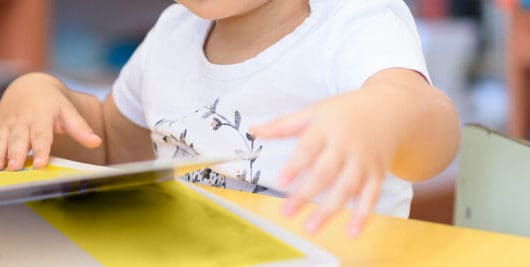It can be incredibly difficult to know what books your three-year-old will enjoy, but that’s only half the challenge: with thousands of children’s books published each year, it often feels impossible to narrow down your options when buying a book for your little one.
But you don’t have to navigate the store’s endless bookshelves alone – we’re here to help. In this guide we’ll be turning the confusing world of books for three-year-olds into an open book by telling you exactly which ones are the best on the market.
- How to Choose a Book for a 3-Year-Old
- Picking the Best Books for Three-Year-Olds
- Top 15 Best Books for 3-Year-Olds 2025
- 1. Best Overall Book for 3-Year-Olds: The Very Hungry Caterpillar
- 2. Best Premium Book: Room on the Broom (Sound Book Version)
- 3. Most Heartwarming Book: The Wonderful Things You Will Be
- 4. Best Educational Book: My First Learn to Write Workbook
- 5. Best Budget Book: Peppa in Space
- 6. Book With the Best Moral: The Gruffalo
- 7. Most Colorful Book: Giraffes Can't Dance
- 8. Best Interactive Book: Press Here
- 9. Best Bedtime Book: The Going to Bed Book
- 10. Best Vehicle Book: Cars and Trucks and Things That Go
- 11. Best Dinosaur Book: How Do Dinosaurs Say Happy Birthday?
- 12. Best Wordless Book: Wolf in the Snow
- 13. Best Book About Emotions: The Color Monster: A Pop-up Book of Feelings
- 14. Best Book for a Soon-to-Be Older Sibling: My New Baby
- 15. Best Touch and Feel Book: Pat the Bunny
- Final Thoughts
How to Choose a Book for a 3-Year-Old
Before we delve into our top picks, you should know there are various types of books for three-year-olds, each with their own benefits. Here’s a close look at the main types.
Board Books
Young children love to chew and bite on things: it’s their way of exploring the world around them. While a paperback would probably end up destroyed in the hands of a curious little one, a board book is a format designed to last: the pages are made from thick, durable paperboard that can withstand anything a toddler puts them through; bites, knocks, slobber, throws – the lot. A board book is also small and has rounded corners, which makes it easy for your little one to handle and turn the pages.
A board book’s content typically caters to a toddler’s attention span and level of comprehension, with simple language, a low word count and easy to understand concepts. Board books also tend to have interactive parts, such as pull-tabs and flaps.
Board books are often regarded as a sub-genre of the picture book, as many picture books come in board book format.
Picture Books
Picture books essentially tell a story driven by eye-catching illustrations. They usually come in paperback or hardback, though sometimes simpler picture books are converted to board book format.
Paperback and hardcover picture books are considered the next step up from board books. They are usually longer (averaging 30 pages), incorporate more complex language and have a more developed plotline (typically a basic character arc).
Activity Books
An activity book features various educational yet fun activities for your child to get involved in. Common activities include writing games and puzzles.
Picking the Best Books for Three-Year-Olds
Here are the factors we considered when determining which books would make it into our top picks:
Subject Matter
Books for three-year-olds come in various genres and have many purposes. Some books aim to be educational, while others aim to simply tickle your little one’s funny bone.
Visual Appeal
Bright colors and captivating art make a great book for a three-year-old. Any artwork should complement the actual story and illustrations shouldn’t be cluttered.
Interactive Elements
Interactive elements such as pop-ups and flaps are entertaining for your child and also help build their fine motor skills (all the movements you make using the smaller muscles of your hands, fingers and wrists).
Language
Playful, repetitive, and rhythmic language is a must; it’s fun for your little one to listen to and it grabs their attention. Rhymes and repetition also help your child to anticipate what comes next in the book (predictable) and make the words and the story itself more memorable. This allows your child to easily chime in and read along. Plus, the more your child is exposed to rhyming text, the more they’ll develop phonological awareness (understanding how sounds work).
Length
Every child has a different attention span, but in general a three-year-old’s attention span is fairly short. Due to this, the length of the book is an important factor to consider, so we’ll mention the number of pages in each book.
Now you have a good understanding of the basics and what factors we considered, it’s time to dive into our choices for the best books for three-year-olds.
Top 15 Best Books for 3-Year-Olds 2025
1. Best Overall Book for 3-Year-Olds: The Very Hungry Caterpillar
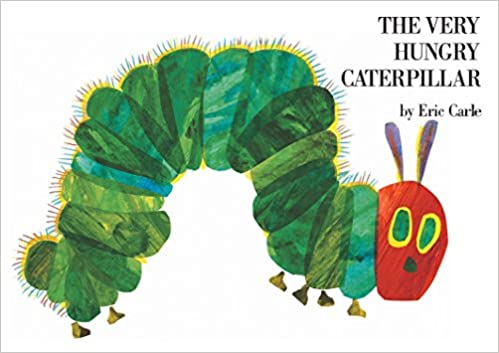
Editor’s Rating:
Quick Facts:
- Format: Paperback, hardcover, board book
- Genre and Themes: Picture book, concept book, bugs, food
- Recommended Age: 2 to 5 years
- Pages: 32 (may vary depending on format)
The Very Hungry Caterpillar is a great early learning picture book (also known as a concept book) which introduces your little one to concepts like colors, counting and time. Besides the educational benefits, it also manages to help your toddler cope with change by showing them how beautiful change can be through the caterpillar’s metamorphosis. This makes the book ideal for children who are going through a big change in their life, as it’s sure to provide reassurance and comfort.
Another great aspect of this book is the various interactive elements that work beautifully in tandem with the plot. For example, there are die-cut holes in the fruit where the caterpillar has taken a “bite.” A curious child will definitely love poking their finger through the holes, and doing so will help develop their fine motor skills.
Keep in mind that while The Very Hungry Caterpillar is a great book to introduce your child to the wonders of animal biology (metamorphosis), there is some misinformation. Caterpillars that turn into butterflies do not spin a cocoon around themselves (it’s actually a chrysalis!).
Visual Appeal
On each page, The Very Hungry Caterpillar typically has one central illustration and leaves the rest of the page blank. This makes it extremely clear to your child what they should be focusing on when listening to the story.
Language
Although The Very Hungry Caterpillar doesn’t incorporate rhymes like Room on the Broom does, it does contain highly repetitive (and memorable) language.
Pros
- Clear illustrations
- Educates on concepts including food, time, colors and counting
- Interactive elements that effectively complement story
- Repetitive, memorable language
- Reassuring for children going through change
Cons
- Some misinformation
- Paperback version does not include interactive elements

Editor’s Rating:
Quick Facts:
- Format: Paperback, board book, sound book
- Genre and Themes: Picture book, comedy, friendship
- Recommended Age: 3 to 7 years
- Pages: 32 (may vary depending on format)
Room on the Broom is a witty story that shows your child the importance of being kind to others and having friends by their side. The plot takes your child on many whacky adventures and boasts the funniest narrative out of all the books we reviewed.
The sound book version has twelve pressable buttons that make the noises of the characters in the book (such as the cat’s purr). Reading the sound book version thus ensures a highly interactive and immersive experience, particularly for those who love silly noises.
The buttons themselves are a great size for small fingers. However, they do require a fair amount of pressure, which some children might struggle with.
Visual Appeal
The illustrations are colorful and vibrant, but what truly makes them stand out is how vivid all the characters’ facial expressions appear. The expressions really bring to light how the characters feel throughout the story, and this is sure to help your child learn how to identify emotions based on facial expressions.
While the illustrations are generally sweet and silly, there are some illustrations your child may find a little scary (the dragon and the “horrible beast”), so it’s best to avoid reading this book at night. If you’re looking for a good bedtime story, check out The Going to Bed Book.
Language
The Room on the Broom is bursting with sing-songy language; rhymes, upbeat words and lots of repetition. The repetition in particular makes it easy for your child to anticipate what comes next and read (or sing!) along.
In some versions, the book’s original phrases have been Americanized (e.g. chips changed to french fries). While this is not necessarily a drawback, some of the phrases as a result of this change do feel less rhythmic.
Pros
- Sweet message about friendship
- Extremely funny
- Vivid facial expressions
- Sing-songy language
- Interactive sound buttons
Cons
- Original phrasing altered
- Some three-year-olds may find buttons hard to press
3. Most Heartwarming Book: The Wonderful Things You Will Be
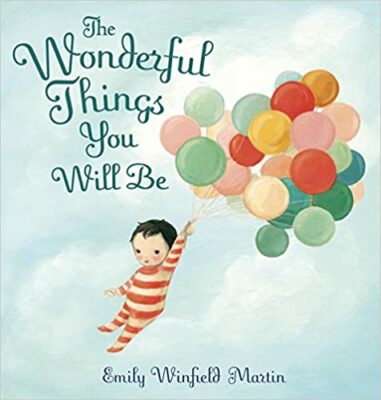
Editor’s Rating:
Quick Facts:
- Format: Hardcover
- Genre and Themes: Picture book, unconditional love, acceptance
- Recommended Age: 3 to 7 years
- Pages: 36
The message in this story is reassuring for any little one: no matter what dreams they follow or who they grow up to be, they will always be loved.
While the message is moving and enjoyable for both parents and children alike, it is fairly abstract and something parents will appreciate more; a three-year-old is unlikely to comprehend the full meaning of the message.
The Wonderful Things You Will Be has a captivating “surprise” at the end for your child: a gatefold that unfolds to reveal a beautiful illustration of all the characters who appeared throughout the story.
Unfortunately, the pages are thin and prone to tearing. If you want something sturdier, we recommend stories that come in board book form like The Very Hungry Caterpillar.
Visual Appeal
The book’s artwork features plenty of diversity, something which many picture books lack. This makes the story something every child can easily relate to, as they’ll be able to visually see at least one character who is just like them.
Language
The language has constant rhyming and a gentle flow, which will certainly soothe your little one.
Pros
- Heartwarming message
- Enjoyable read for both parents and children
- Diversity
- Soothing rhythm
- Captivating gatefold surprise
Cons
- A message catered more to parents than children
- Thin pages
4. Best Educational Book: My First Learn to Write Workbook
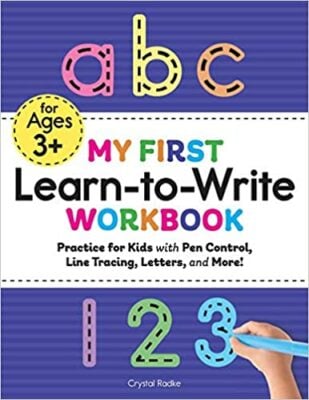
Editor’s Rating:
Quick Facts:
- Format: Paperback, spiral-bound
- Genre and Themes: Activity book, concept book, writing
- Recommended Age: 3 to 5 years
- Pages: 84 (may vary depending on format)
At three, your little one is just beginning to learn how to properly hold a marker, and they’ve probably spent many hours scribbling away on paper (and your furniture!). If you’re looking to improve their fine motor skills – particularly when it comes to the basic motions of writing (pre-writing skills) – this workbook is your best bet. Filled with dozens of activities like line tracing, letter tracing and coloring in shapes, your child has plenty of ways to practice.
What further makes this workbook an excellent interactive experience is the certificate of completion pages. When your child finishes a section, they get a certificate as a reward. This aspect is sure to cause your little one to feel proud of what they’ve accomplished.
Unfortunately, the pages in this workbook are not wipeable or erasable, so if your child makes a mistake you can’t remove the marks.
Visual Appeal
The activities utilize various colors and styles, which helps keep your little one interested. One activity even turns simple line tracing into a fun car race, where your child has to trace the cars’ paths to help them get to the finish line.
Language
The language is simple enough for your child to understand what’s being asked of them and how to complete the tasks.
Pros
- Great for improving fine motor skills
- Helps your child learn the fundamentals of writing
- Plenty of activities to try out
- Rewarded with certificates
Cons
- Not wipeable or erasable
5. Best Budget Book: Peppa in Space
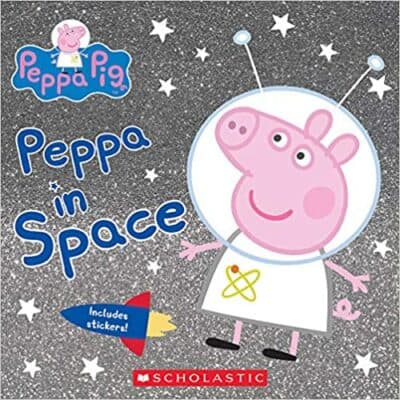
Editor’s Rating:
Quick Facts:
- Format: Paperback
- Genre and Themes: Picture book, concept book, space
- Recommended Age: 3 to 5 years
- Pages: 24
If you want to teach your little one about outer space, Peppa in Space is the perfect book to start with. It covers information like planets and gravity in an understandable and fun way. While a great read for Peppa Pig fans, your child doesn’t need to be a Peppa Pig fan to truly appreciate this story.
This book comes with twelve Peppa Pig and space themed stickers, which will please any sticker-obsessed little one. The stickers are large in size, making them easy to use no matter how small your little one’s fingers are.
Similar to The Wonderful Things You Will Be, this book’s pages are thin and easily tear, so this book is not suitable if your child has a tendency to be rough with books. Another sturdy book you can try is The Gruffalo.
Visual Appeal
Peppa in Space has the most visually appealing cover by far. Its glitter will instantly catch your child’s eye and is sure to make them feel as if the book will truly transport them to outer space.
Language
Generally, the language is a little flat – it lacks rhythm and there’s minimal repetition. Nevertheless, the book is highly effective at introducing and explaining new scientific language (such as planet names) to your little one. It also has an extremely fun countdown phrase relating to a rocket launch: “5 4 3 2 1 BLAST OFF.” The countdown will definitely encourage your child to chime in, and they’ll get excited at the anticipation of hearing “BLAST OFF.”
Pros
- Ideal for Peppa Pig fans
- Glitter cover
- Twelve stickers
- Introduces your little one to space
- Extremely affordable
Cons
- Thin pages
- Language a little flat
6. Book With the Best Moral: The Gruffalo

Editor’s Rating:
Quick Facts:
- Format: Paperback, hardcover, board book
- Genre and Themes: Picture book, animals, fantasy, moral lesson
- Recommended Age: 3 to 7 years
- Pages: 32 (may vary depending on format)
The Gruffalo is written by the same author (Julia Donaldson) of Room on the Broom, and the similarities are apparent: fantasy elements, witty characters and a whacky adventure at its core. However, the main difference between the two is the message they share. While Room on the Broom shows your child the importance of friendship, The Gruffalo teaches a vital moral lesson: brains triumph over brawn.
The Gruffalo’s plot is also all about using your imagination to come up with creative solutions. Due to this, this book is ideal at encouraging your children to think creatively.
Although both Room on the Broom and The Gruffalo have some scary scenes, The Gruffalo is a little scarier due to the fact that the mouse is always in harm’s way.
Visual Appeal
Julia Donaldson works with the same illustrator on this book, so it’s no surprise the illustrations are just as vibrant as the ones found in Room on the Broom. However, the facial expressions aren’t as expressive.
Language
The Gruffalo has the same rhythmic language present in most of Julia Donaldson’s books, though the vocabulary is a little more advanced than others. If your little one struggles with vocabulary, sticking to a book with simpler language like The Very Hungry Caterpillar or a wordless book such as Wolf in the Snow might be best.
Similar to Room on the Broom, in some versions the book’s original text has also been Americanized; some of the rhymes are completely changed and the flow is a little off.
Pros
- Teaches good moral about friendship and kindness
- Encourages creative thinking
- Vibrant illustrations
- Rhythmic language
Cons
- Can be a little scary
- Changed rhymes in some versions, flow a little off
7. Most Colorful Book: Giraffes Can't Dance
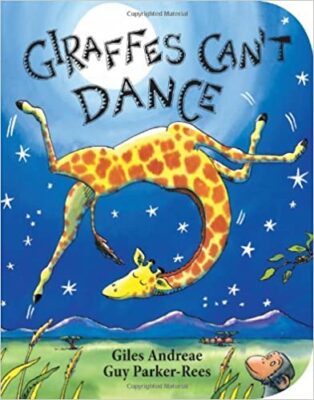
Editor’s Rating:
Quick Facts:
- Type(s): Paperback, hardcover, board book
- Genre and Themes: Picture book, self-confidence, animals, dance
- Recommended Age: 3 to 5 years
- Pages: 32
Giraffe Can’t Dance makes for a fun read and also imparts a meaningful message: we all have our own personal strengths, and sometimes we just need self-belief and a little support to find them. Due to this message, it’s a great book to help build your little one’s self-confidence.
However, keep in mind you may need to clarify the message for your child as it can potentially be interpreted as needing to fit in to be liked. There are also scenes of bullying and teasing which might be upsetting for some children.
If your little one loves animals, Giraffe Can’t Dance is the perfect book. From giraffes to warthogs, there’s plenty of jungle animals for your children to learn about.
Visual Appeal
Giraffe Can’t Dance’s illustrations are more striking than any others we reviewed. Bright, colorful and bold, illustrator Guy Parker-Rees has effectively managed to turn a dark jungle into a warm and welcoming place your child will love. The full-page illustrations are particularly mesmerizing, and feature animals doing lots of giggle-inducing silly actions (like a giraffe doing a backward somersault).
Language
Similar to Room on the Broom, the language is sing-songy and very playful. Giraffe Can’t Dance also has plenty of new words for your child to learn.
Pros
- Has the most striking illustrations
- Perfect for animal-obsessed children
- Lots of opportunities for learning new words
- Sing-songy language
Cons
- Underlying message slightly questionable
- Includes scenes of bullying
8. Best Interactive Book: Press Here
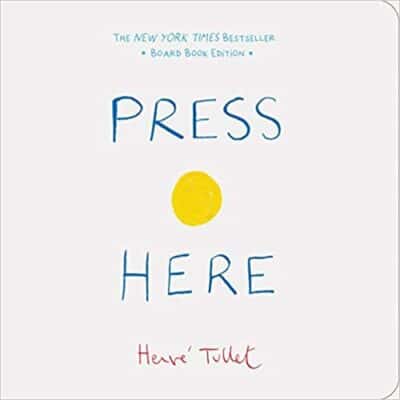
Editor’s Rating:
Quick Facts:
- Type(s): Hardcover, board book
- Genre and Themes: Picture book, interactive, colors
- Recommended Age: 3 to 5 years
- Pages: 46 (may vary depending on format)
It’s the longest-running picture book on the New York Times bestseller list for a reason: it manages to highly engage a child’s imagination while also helping them learn basic concepts and how to follow instructions. Press Here is even great at helping your child think about cause and effect, as it encourages them to anticipate how the book will respond to their actions.
While Press Here is a lot simpler compared to other interactive books (it has no moving parts like Pat the Bunny), it is extremely effective at getting your child to interact with the book in other ways. For example, it encourages your child to shake the book, tap on the book and even clap their hands. This makes Press Here the best choice for energetic kids.
Moreover, each page encourages parents and children alike to get involved, making it an ideal option if you’re looking for a book to strengthen your parent-child bond.
That being said, the book is heavily reliant on your child following the instructions. If your child ignores the instructions, or figures out the next page’s outcome is the same whether or not they follow the previous page’s instructions, the book loses all its appeal.
The hardcover version’s pages are also fairly thin.
Visual Appeal
Despite having very minimal illustrations (colorful dots), there’s a certain appeal in how the dots change shapes, size and colors throughout the story. For a child, the dots’ transformations will feel magical.
Language
Although the language lacks rhyme and rhythm, it is personable and almost feels like the book is speaking directly to your little one, with phrases like “oops. That might have been a little too hard.” Plus, after your child completes a task and turns to the next page, the book praises them. This helps your child to feel proud of their accomplishment, which in turn keeps them engaged.
Pros
- Extremely interactive
- Helps child learn about concepts and how to follow instructions
- Warm language that praises child’s accomplishments
- Great for parent-child bonding
Cons
- Entirely reliant on child following instructions
- Hardback version’s pages thin
9. Best Bedtime Book: The Going to Bed Book
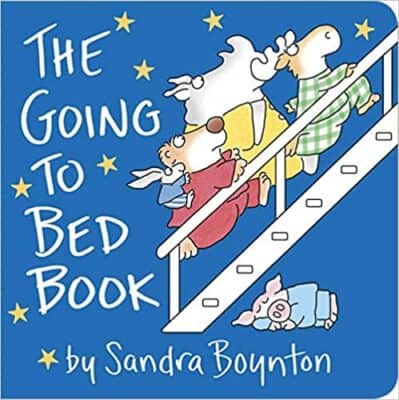
Editor’s Rating:
Quick Facts:
- Format: Hardcover, board book
- Genre and Themes: Picture book, concept book, bedtime story, animals
- Recommended Age: 2 to 5 years
- Pages: 14
If your little one loves avoiding bedtime as much as possible, this book will be your savior. Not only does it teach your child a bedtime routine, (and how fun participating in a bedtime routine can be!), it’s also incredibly soothing and helps calm your little one down.
While the routine is great overall, there is a questionable part that tells your child to exercise just before getting into bed. Exercising just before bed can potentially make your child energetic, which isn’t ideal if you’re trying to get them to sleep!
The Going to Bed Book is also extremely short, so it may feel a little too abrupt for some three-year-olds. If this is the case, you could potentially use The Wonderful Things You Will Be as a bedtime story instead; it’s longer and soothes your child as well. However, it doesn’t teach a bedtime routine like The Going to Bed Book does.
Visual Appeal
The illustrations are bright, clear and not too cluttered. This allows your little one to easily focus on the actions in the book. Although the illustrations feature plenty of animals – which an animal-loving kid will appreciate – they aren’t as eye-catching as the animal illustrations in Giraffe Can’t Dance.
Language
In general, the phrases are fun and easy for your child to remember (rhymes and repetition), making the book an ideal way for them to learn a bedtime routine. The ending phrase, “rock and rock to sleep,” is particularly effective at soothing your child
Pros
- Ideal bedtime story, great way to teach your child a bedtime routine
- Bright and clear illustrations
- Fun, soothing language
Cons
- Unusual routine sequence order
- Too short for some three-year-olds
10. Best Vehicle Book: Cars and Trucks and Things That Go
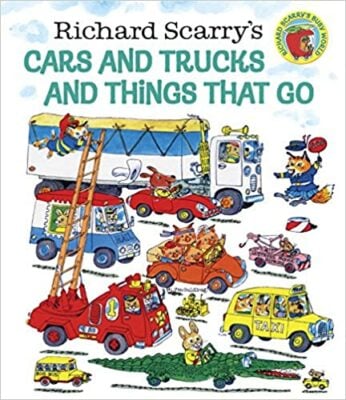
Editor’s Rating:
Quick Facts:
- Format: Hardcover
- Genre and Themes: Picture book, activity book, concept book, vehicles
- Recommended Age: 3 to 7 years
- Pages: 72
Besides featuring dozens upon dozens of vehicles, there’s also plenty of little stories linked to the vehicles throughout to keep your child entertained.
A particularly great feature of this book is its interactive spot the Goldbug game; every page has a hidden Goldbug (a smiling yellow insect) for your child to discover. This makes the book fun for even those who aren’t obsessed with vehicles.
If your little one struggles to concentrate for long periods of time, this book is ideal as it has plenty of instances where you can pause without the flow being disrupted.
This book is dated, and in some instances it does show its age when it comes to gender (a fair few stories reinforce gender stereotypes). If you’d rather avoid exposing your child to gender stereotypes, it might be best to keep away from this book.
Visual Appeal
Cars and Trucks and Things That Go is a vehicle lovers’ dream – it features illustrations of all the vehicles you could possibly think of. There are also some hilarious made up vehicles (like a donut car), which are sure to get a giggle out of your little one.
Unfortunately, the artwork in general is extremely busy and cluttered. This might make it hard for your three-year-old to focus on one particular thing, which could actually make them lose interest in this book. If you want to stick to a book with simpler (and clutter-free) artwork, The Very Hungry Caterpillar is more suitable.
Language
Every vehicle is labeled with its specific name. This really helps your child to pick up new vehicle-related terminology.
Pros
- A vehicle-loving child’s dream book
- Teaches all about vehicles
- Fun spot the Goldbug game
- Can take a break from it without disrupting flow
Cons
- Shows its age when it comes to gender
- Busy illustrations
11. Best Dinosaur Book: How Do Dinosaurs Say Happy Birthday?
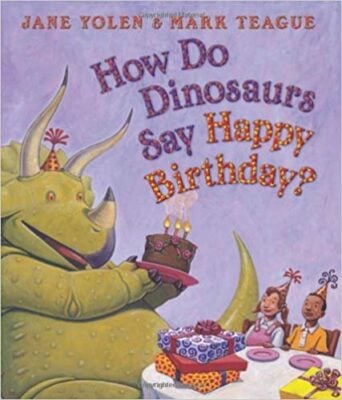
Editor’s Rating:
Quick Facts:
- Format: Hardcover, board book
- Genre and Themes: Picture book, dinosaurs, birthday
- Recommended Age: 3 to 5 years
- Pages: 12
Struggling to find the best birthday gift for you dinosaur-obsessed little one? Then look no further because this book is perfect: the entire story revolves around how dinosaur children celebrate their birthday.
Besides being a fun read, it’s also great at teaching your child party manners. It shows bad manners (like snatching presents), and then emphasizes that dinosaur children don’t behave like this, and instead have good manners (such as thanking guests and sharing cake). Your dinosaur-loving child will definitely want to behave like a dinosaur, which of course will encourage them to adopt these good manners.
Keep in mind the book is short and fairly small in size, especially compared to other books on the market. If you want a bigger and longer book, you could try Room on the Broom as it boasts a nice size and length, and also features a dinosaur-like creature (a dragon).
Visual Appeal
All the dinosaurs are unique – each one has its own individual color and scale pattern. The various colors and patterns of the dinosaurs are sure to hold your child’s attention.
Language
The book has plenty of rhymes to keep your child entertained. It even has a sweet happy birthday message surprise at the end for them – “Happy birthday to you, little dinosaur.”
However, be aware that the dinosaurs featured are all female (book uses “she” pronouns throughout), which may cause boys to struggle to relate to the story (particularly to the happy birthday message at the end).
Pros
- Teaches good party manners
- Ideal birthday gift for dinosaur lover
- Every dinosaur is unique
Cons
- Gender-specific
- Small and fairly short
12. Best Wordless Book: Wolf in the Snow
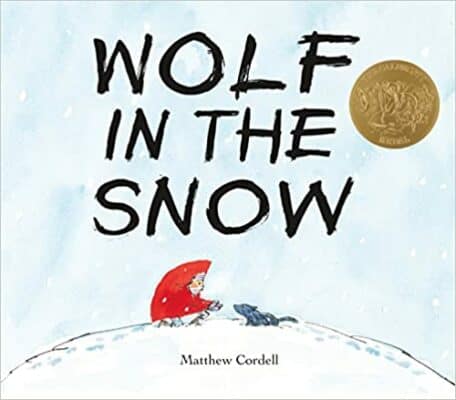
Editor’s Rating:
Quick Facts:
- Format: Paperback, hardcover
- Genre and Themes: Wordless picture book, Christmas, friendship
- Recommended Age: 3 to 5 years
- Pages: 48
Despite having no words, the story based on the pictures alone is heartwarming: a child and wolf cub come together to help each other find their way home. It also shows your child that friendship can come from even the most unlikely places. Of course, as it’s a (mostly) wordless book, it does rely on your child interpreting this underlying message. You will likely have to guide your child as they interpret the story to ensure they understand the message.
If you want a more obvious tale about the importance of friendship, Room on the Broom is your best bet.
Visual Appeal
Although the artwork has a great Christmassy feel with lots of snowy scenes, the colors are fairly weak. In some parts the background elements (like the trees) aren’t well-defined.
Language
While the story is mostly wordless, there are a few onomatopoeias like “bark” and “howl” your child will love to say and act out (especially the howls!). Wordless picture books like this one are perfect for boosting your child’s creativity, as they encourage your child to take on the role of storyteller. Playful Learning provides an in-depth look at the benefits of wordless picture books.
Pros
- Helps child to think creatively
- Christmassy feel, ideal Christmas gift
- Moving message about friendship
- Fun onomatopoeias
Cons
- Illustrations lack vibrancy, background elements not well-defined
- Requires “right” interpretation for underlying message to be appreciated
13. Best Book About Emotions: The Color Monster: A Pop-up Book of Feelings
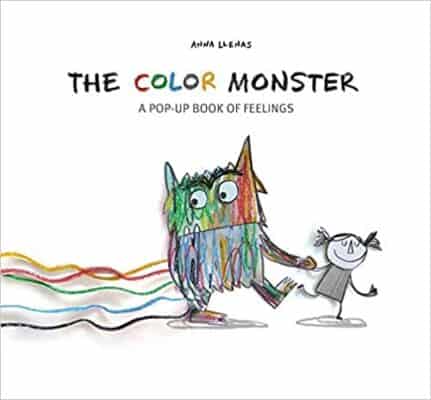
Editor’s Rating:
Quick Facts:
- Format: Hardcover
- Genre and Themes: Picture book, pop-up, emotions
- Recommended Age: 3 to 7 years
- Pages: 20
Happiness, sadness, anger – this book explores all the emotions your little one will be dealing with. The Color Monster is sure to help your child identify exactly what they’re feeling.
The 3D pop-up elements really make this book come alive. Every illustration quite literally jumps out at you and your little one, which is sure to captivate their attention. Unfortunately, the pop-ups themselves are very fragile, and if parts of the pop-ups do break, they pose a choking hazard. If you’d prefer to avoid this risk completely, there is a version of The Color Monster without pop-ups, which you can find here.
Visual Appeal
It’s called The Color Monster for a reason: the illustrations are extremely bold and encompass a wide range of hues. Each emotion is given its own color; happiness is “yellow like the sun,” while sadness is “blue like a rainy day.” This helps your child associate emotions with colors.
Language
This book explains emotions using easy to understand language. That being said, the emotion “calm” could be better described. The wording “you feel at peace” is fairly abstract, and many three-year-olds will struggle to understand this.
Pros
- Great for helping child make sense of their emotions
- Fun 3D pop-ups
- Helps child associate emotions with colors
- Multicolored illustrations
Cons
- Choking hazard
- Not gender-neutral
- “Calm” could be better described
14. Best Book for a Soon-to-Be Older Sibling: My New Baby
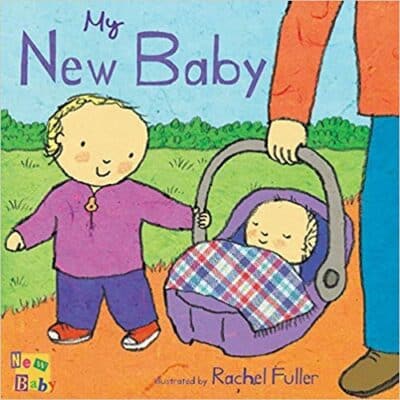
Editor’s Rating:
Quick Facts:
- Format: Hardcover, board book
- Genre and Themes: Picture book, new sibling, baby care
- Recommended Age: 2 to 5 years
- Pages: 12 (may vary depending on format)
The arrival of a new sibling can be difficult for your three-year-old; change can be incredibly daunting, especially when that change involves the family dynamic. This book shows your little one that change isn’t a bad thing, and a new family member is something that’ll be a positive experience, rather than something to be fearful of.
However, there isn’t really a plot to this book, so it may fail to capture the interest of three-year-olds who enjoy a storyline. If you want to help prepare your little one for change but want a book that does this using a storyline, The Very Hungry Caterpillar is better suited.
Visual Appeal
The illustrations aren’t cluttered, and the characters are gender-neutral, making the book ideal for both soon-to-be older brothers and older sisters. Moreover, there are plenty of breastfeeding scenes throughout, something which many books aimed at three-year-olds lack. This really helps to normalize breastfeeding.
Language
Most of the sentences are phrased as questions (such as “Is baby clean yet?”) which enables you to start a discussion with your child about the topic on the page. Unfortunately, the language overall is very dull and lacks flow.
Pros
- Helps child cope with arrival of new sibling
- Normalizes breast feeding
- Questions initiate discussion
- Gender-neutral illustrations
Cons
- No plot
- Very dull language, lacks flow
15. Best Touch and Feel Book: Pat the Bunny
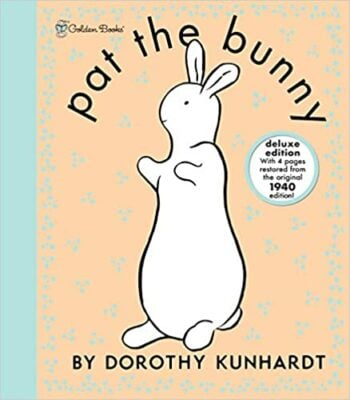
Editor’s Rating:
Quick Facts:
- Format: Paperback, hardcover
- Genre and Themes: Picture book, touch and feel, interactive
- Recommended Age: 0 to 3 years
- Pages: 24 (may vary depending on format)
Pat the Bunny will satisfy any little one hooked on touch and feel books. It has everything you could possibly imagine – flaps, die-cut holes, various textures and even a mini-book your child can flick through. Other unique interactive elements include scented flowers your child can sniff and a mirror they can admire themselves in.
All of these interactive features make Pat the Bunny a great way to build your child’s fine motor skills. Your child is also told to mimic the actions the two children do on each page, which helps teach them how to follow instructions.
Unfortunately, the binding of this book is poor quality (made of plastic comb) and easily breaks. This is particularly frustrating, considering this book is intended to be handled in various ways!
Visual Appeal
The illustrations are clean and simple, though the colors are fairly dull, especially compared to an interactive book like Press Here which makes use of vibrant colors.
Language
The language is extremely simple and a bit too basic for a three-year-old. It doesn’t really help to expand your child’s vocabulary.
Pros
- Great for engaging child’s senses
- Touch and feel, ideal for building fine motor skills
- Helps child learn how to follow instructions
Cons
- Poor quality binding
- Doesn’t really expose child to new vocabulary
- Dull colors
Final Thoughts
Books let your three-year-old go on exciting adventures, whether deep in the jungle where animals dance away or high in the sky where witches fly. They also aid your little one’s personal growth and strengthen the parent-child bond you share.
Taking the time to find the right book is sure to help your child learn to love reading and turn them into an avid bookworm. After all, these years of story time are precious and hold moments your little one will treasure for years to come.
